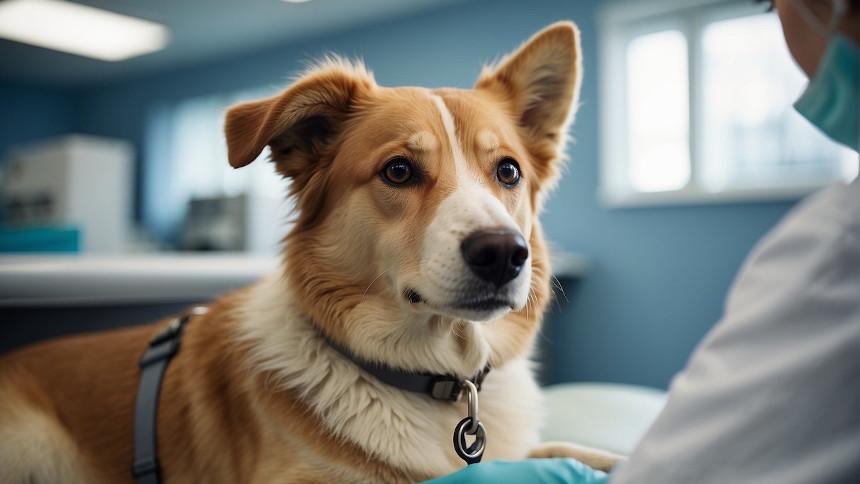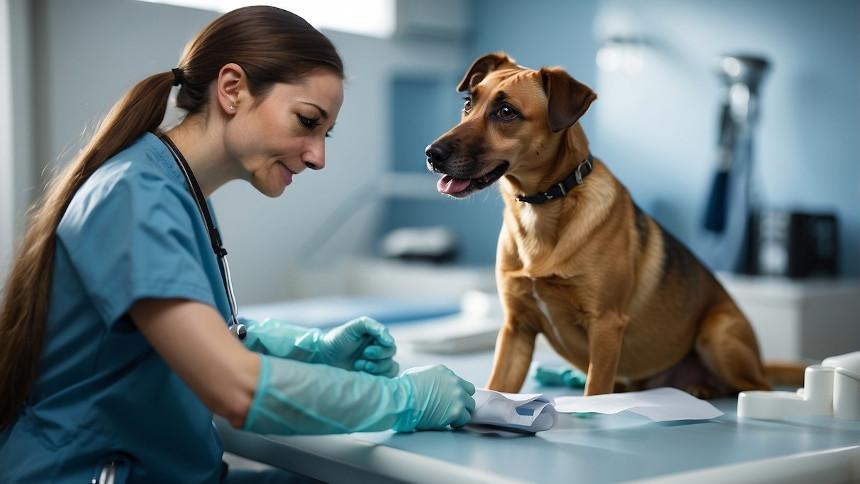When vaccinating dogs, veterinarians follow specific guidelines to ensure the health and safety of canine patients. These guidelines are determined by organizations such as the American Animal Hospital Association (AAHA), which recommends standardized practices for administering vaccinations. The sites chosen for injections on a dog’s body are not arbitrary; they are selected based on factors that include vaccine type, the dog’s anatomical structure, and the potential for monitoring any adverse reactions.
Most vaccinations are administered via injection in specific areas of a dog’s body. Core vaccines, those deemed essential for all dogs due to the risk and severity of the diseases they prevent, are typically given in the muscle or just under the skin. For example, the rabies vaccine is often administered in the right hind leg, while other core vaccines like distemper, parvovirus, and adenovirus are commonly given in the region of the right shoulder. This systematic approach to vaccine locations helps veterinarians and healthcare professionals quickly identify and respond to any vaccine reactions, and allows for an organized vaccination record.
Non-core vaccines, tailored to a dog’s lifestyle and the prevalence of certain diseases in the area, may be given at different sites. Some vaccines, particularly those for respiratory pathogens like Bordetella bronchiseptica, may be given intranasally instead of by injection. The choice between intranasal and injectable vaccines, as well as their specific administration sites, are influenced by factors such as the dog’s health status, age, breed, and potential exposure to disease. The vet plays a crucial role in determining the most appropriate vaccine protocol for each individual dog, ensuring optimal protection and minimal risk.
Understanding Dog Vaccinations
Dog vaccinations are essential for the health and well-being of canines, playing a pivotal role in protecting them from various infectious diseases. They are typically administered at specific sites on the body according to established veterinary guidelines.
Types of Vaccines
Dog vaccines can be categorized based upon the way they are formulated:
- Live attenuated vaccines: Contain a weakened form of the virus which is still capable of causing a mild form of the disease to stimulate immunity.
- Killed (inactivated) vaccines: Contain viruses that have been killed to prevent them from causing disease, while still invoking an immune response.
- Recombinant vaccines: Utilize gene segments from the virus to stimulate an immune response without the risk of causing the actual disease.
Vaccines are also distinguished by the method of administration, with most administered via injection. Intranasal vaccines, such as the bordetella vaccine, and oral vaccines are also used for some diseases.
Core vs Non-Core Vaccines
Core vaccines are recommended for all dogs regardless of their circumstances. These vaccines provide immunization against diseases that are widespread, cause severe illness, or are transmissible to humans:
- Rabies: Required by law in many places due to its zoonotic and fatal nature.
- Canine Distemper: A severe and highly infectious viral disease affecting many body systems.
- Canine Parvovirus (Parvo): Known for severe gastrointestinal symptoms, highly contagious.
- Canine Adenovirus Type 2 (Hepatitis): Protects against infectious hepatitis and respiratory disease caused by adenoviruses.
- Canine Parainfluenza: Contributes to kennel cough, a highly contagious respiratory disease.
Non-core vaccines are given based on the dog’s exposure risk which can be influenced by factors like lifestyle, geographic location, and the presence of other dogs:
- Bordetella Bronchiseptica: Causes kennel cough and is mostly given to dogs that are boarded, attend daycare, or dog parks.
- Leptospirosis: A bacterial disease that can be contracted from wildlife or contaminated water.
- Canine Influenza: A relatively new viral respiratory infection in dogs.
- Lyme Disease: Transmitted by ticks; vaccination is recommended in areas where Lyme disease is prevalent.
Decisions regarding non-core vaccines are made by the veterinarian based on an assessment of the dog’s individual risk. Immunization against these diseases can prevent health complications and even save a dog’s life, underscoring the critical role of vaccines in canine healthcare.
Importance of Vaccination in Canines
Vaccination plays a crucial role in maintaining the health of canines. It serves as a preventive measure that equips the immune system to combat a variety of diseases. Vaccinations work by introducing a weakened or killed pathogen into the body, prompting the immune system to produce antibodies. This preparation allows the canine’s body to swiftly respond to future infections.
Core vaccines are essential for all dogs as they protect against highly contagious and potentially fatal diseases. For example, vaccines against canine distemper virus and canine parvovirus are considered core because these viruses can seriously affect a dog’s respiratory, gastrointestinal, and nervous systems.
Non-core vaccines, such as those for Lyme disease and leptospirosis, are tailored to a dog’s exposure risk. Lyme disease is caused by bacteria transmitted via ticks, and leptospirosis is a bacterial disease that can affect many animals, including dogs and humans. Vaccinating against these diseases is especially important for dogs that live in or travel to areas where such infections are prevalent.
Infection control through vaccination not only protects individual dogs but also helps in the control of diseases within the overall canine population. By maintaining a high level of immunity in a population (herd immunity), the spread of contagious diseases is minimized, protecting both vaccinated and unvaccinated dogs.
Vaccination schedules and the selection of appropriate vaccines are determined based on a dog’s lifestyle, age, and health status. Veterinarians are the best resource for providing recommendations tailored to each individual canine.
- Core Vaccines: Distemper, Parvovirus
- Non-Core Vaccines: Lyme, Leptospirosis
Regular vaccination is a key aspect of a preventive health care plan, ensuring a longer, healthier life for canines.
Vaccination Schedule and Frequency
Vaccines play a crucial role in protecting dogs at various life stages. They work by preparing a dog’s immune system to recognize and fight diseases efficiently. Adherence to the recommended vaccination schedule is vital to maintain their health.
Puppy Vaccination Schedule
Puppies typically start receiving vaccinations from 6 weeks of age. They should receive a series of vaccines every 3 to 4 weeks until they are about 16 weeks old. The core vaccines, vital for all puppies, include:
- Canine parvovirus
- Canine distemper
- Canine adenovirus type 2
- Rabies (as per legal requirement)
Initial doses boost the immune system, while subsequent doses ensure long-term immunity. Noncore vaccines may be administered depending on the puppy’s environment and lifestyle.
Adult Dog Vaccination Schedule
Once dogs reach adulthood, the frequency of vaccinations changes. Adult dogs typically receive booster shots:
- Every 1 year for noncore vaccines, if required.
- Every 3 years for core vaccines like DAP (Distemper, Adenovirus, Parvovirus) and rabies, following the initial annual booster.
The veterinarian will recommend a personalized vaccination schedule based on the dog’s age, health, and risk of exposure to certain diseases. Regular boosters help maintain the dog’s immune system against preventable diseases.
Safety and Possible Side Effects
Vaccinating dogs is essential for their health, but it is vital to be aware of possible side effects, which mostly manifest as mild reactions. Safety in vaccination protocols is prioritized to minimize risks and ensure proper canine health.
Common Side Effects
Following a vaccination, dogs may experience several benign symptoms as their immune system responds to the vaccine. Basic observations post-vaccination may include:
- Lethargy: A temporary decrease in energy levels.
- Soreness: Discomfort or pain at the injection site.
- Swelling: Mild swelling may occur where the vaccine was administered.
- Fever: A low-grade fever can be a natural immune response.
These symptoms are usually short-lived, resolving without the need for intervention within a few days.
Allergic Reactions and Complications
Although rare, some dogs may exhibit more serious reactions that can indicate an allergic response or complication, which include:
- Vomiting and Diarrhea: Signs of gastrointestinal upset.
- Difficulty Breathing: Severe allergic reactions may lead to respiratory distress.
- Hives or Facial Swelling: Visible signs of an allergic reaction.
Should a dog exhibit these symptoms, it is crucial to contact a veterinarian immediately. An allergic reaction may escalate quickly, needing prompt medical attention to ensure the safety and well-being of the pet.
Dog Vaccine Administration Sites
When vaccinating a dog, the location of the vaccine administration is carefully selected based on the type of vaccine and the recommended guidelines to ensure efficacy and safety. Each route of administration has specific sites on the dog’s body designated for injections or applications.
Intramuscular Vaccinations
Intramuscular (IM) vaccines are administered directly into the muscle. One of the common muscles used for IM injections is the quadriceps muscle located on the front part of the dog’s thigh. This location is chosen due to its large muscle mass, making it suitable for the absorption of vaccines. Veterinarians are trained to administer IM vaccines carefully to avoid nerves and bones.
Subcutaneous Vaccinations
Subcutaneous (SC) vaccinations are given beneath the skin but above the muscle. A preferred site for SC injections is the loose skin over the shoulder or the lateral aspect of the thigh. This method is often used for vaccines that can cause mild reactions, as the loose skin provides a buffer.
- Locations for SC vaccinations include:
- Loose skin over the shoulder
- Lateral aspect of the thigh
Care is taken to vary the exact location of SC injections to prevent site discomfort and to ensure proper vaccine distribution.
Intranasal Vaccinations
For intranasal (IN) vaccines, the administration site is the nasal cavity of the dog. These vaccines are typically used to protect against respiratory viruses and are given as drops or a spray directly into the nostrils. Vaccinating intranasally can provide a quick immune response at the entrance where these pathogens typically enter the body. Since this route requires no needles, it is often less stressful for the dog compared to injections.
Vaccination Guidelines and Veterinary Care
Veterinarians administer vaccinations to dogs following well-established guidelines that ensure both efficacy and safety. Emphasizing the importance of location-specific injections and tailored revaccination schedules, veterinary care relies on these structured protocols.
American Animal Hospital Association Guidelines
The American Animal Hospital Association (AAHA) sets forth comprehensive guidelines that veterinarians adhere to when vaccinating dogs. These guidelines distinguish between core and non-core vaccines, providing a framework for identifying which immunizations are essential for all dogs and which are specific to an individual dog’s risk of exposure.
Core vaccines are highlighted as crucial for all dogs, irrespective of their lifestyle, and include:
- Rabies
- Canine Parvovirus
- Canine Distemper
- Hepatitis
AAHA guidelines recommend specific body sites for each vaccine to facilitate precise identification of any adverse reactions. Furthermore, the guidelines address the revaccination frequency, catering to factors such as age, health status, and vaccination history to tailor the immunization protocol.
Veterinarian Recommendations
Veterinarians use the AAHA guidelines as a foundation to deliver personalized care. They consider an individual dog’s health, lifestyle, and previous vaccination history when determining the most appropriate vaccine strategy. Locations for vaccine administration are carefully selected based on these standards:
- Rabies vaccine is typically given in the right rear leg.
- Vaccines for distemper, adenovirus, parainfluenza, and parvovirus are often administered in the right front leg.
- Non-core vaccines are given in the left rear leg.
This systematic approach ensures that if a dog experiences a reaction, the veterinarian can swiftly identify the cause. Veterinarians remain vigilant throughout the entire vaccination process, ready to address any potential issues with immediate and appropriate veterinary care.
Common Canine Vaccines and Disease Prevention
In ensuring canine health, vaccinations play a pivotal role in preventing serious diseases. This section will explore the primary vaccines recommended to shield dogs from life-threatening illnesses.
Rabies Vaccine
Rabies, a fatal disease affecting the central nervous system, is preventable through vaccination. The rabies vaccine is legally required in many places due to the public health risk posed if a dog contracts and transmits the virus. The initial vaccine is typically administered between 12 to 16 weeks of age, with a booster after one year and subsequent boosters every one to three years as advised by a veterinarian.
DHPP and Bordetella Vaccines
DHPP is a combination vaccine that protects against four diseases: Distemper (D), Hepatitis (H), Parainfluenza virus (P), and Parvovirus (P).
- Distemper: Affects respiratory, gastrointestinal, and nervous systems.
- Hepatitis: Targets the liver and other organs.
- Parainfluenza: Respiratory virus that can cause coughing.
- Parvovirus: Highly contagious virus causing severe gastrointestinal distress.
These core vaccines are given initially in a series of shots to puppies and are followed by regular boosters.
The Bordetella vaccine is specifically aimed at preventing kennel cough, an upper respiratory infection caused by the Bordetella bronchiseptica bacterium. This non-core vaccine is recommended for dogs that frequent kennels, dog parks, or social enclaves.
Lyme and Leptospirosis Vaccines
The Lyme vaccine protects against Lyme disease, caused by the Borrelia burgdorferi bacteria, transmitted by ticks. This non-core vaccine is recommended for dogs in areas where Lyme disease is prevalent or for those who travel to such regions.
The Leptospirosis vaccine shields against a bacterial disease that can affect a dog’s kidneys, liver, and other organs. It can be fatal if left untreated. The risk of this disease can vary greatly; therefore, vaccination is usually recommended based on the dog’s lifestyle and geographic risk of exposure.








